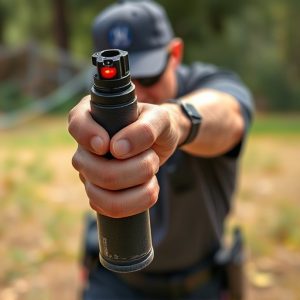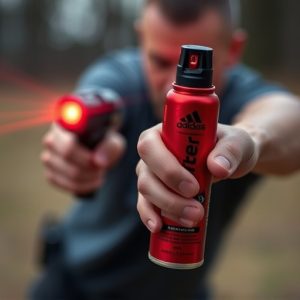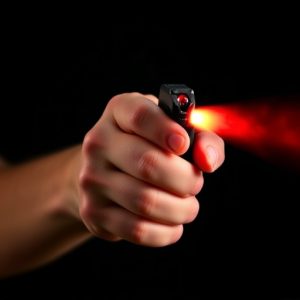Bear Spray vs. Personal Pepper Spray: Choosing Your Safety Defense
When choosing between bear spray and personal pepper spray, consider your needs: bear spray for dist…….
When choosing between bear spray and personal pepper spray, consider your needs: bear spray for distancing wildlife from a distance up to 20 feet using capsaicin oil, or pepper spray for immediate pain and disorientation in close quarters (4-5 foot range). Bear spray is more effective against large animals, while pepper spray acts faster against humans. Both have legal considerations; choose based on specific safety needs and local regulations.
Personal protection devices, especially those designed for outdoor enthusiasts and self-defense, often incorporate chemical irritants like bear spray or personal pepper spray. These substances play a crucial role in deterring potential threats. This article delves into the world of chemical irritants, focusing on their significance in personal safety gear. We’ll explore the differences between bear spray and personal pepper spray, highlighting their unique properties and suitability for various scenarios. Understanding these options can help individuals make informed choices to ensure their well-being.
- Understanding Chemical Irritants: Their Role in Personal Protection Devices
- Bear Spray vs. Personal Pepper Spray: A Comparative Analysis
- Choosing the Right Irritant for Your Safety Needs
Understanding Chemical Irritants: Their Role in Personal Protection Devices
Understanding Chemical Irritants: Their Role in Personal Protection Devices
Chemical irritants play a pivotal role in personal protection devices, offering individuals an effective means to deter and defend against potential threats. Among these, bear spray and personal pepper spray stand out as popular choices for outdoor enthusiasts and self-defense advocates alike. Bear spray, designed specifically for wildlife encounters, utilizes capsaicin, the active ingredient found in chili peppers, to create a powerful irritant that can temporarily disable an aggressor at a safe distance. In contrast, personal pepper spray disperses a fine aerosol containing capsaicin derivatives, causing immediate pain and disorientation in close-quarters situations.
Both types of chemical irritants serve as game changers in self-defense strategies, but they operate on different principles. Pepper spray’s rapid action and proximity effect make it ideal for close encounters, while bear spray’s extended range and durability make it a preferred choice for outdoor activities where wildlife interaction is a concern. Understanding these differences is crucial when selecting the appropriate chemical irritant for personal protection, ensuring individuals are equipped to navigate potential threats effectively.
Bear Spray vs. Personal Pepper Spray: A Comparative Analysis
When it comes to personal protection devices, choosing between bear spray and personal pepper spray depends on your specific needs. Both serve as effective deterrents against potential threats, but they operate differently. Bear spray is designed to create a barrier of capsaicin oil, temporarily blinding and disorienting the target animal, making escape or de-escalation possible. It’s primarily used for protection against large wildlife like bears, hence its name. On the other hand, personal pepper spray targets the eyes, respiratory system, and skin, causing temporary but intense discomfort to humans or animals that may be threatening you. This makes it more versatile for various scenarios, from urban street encounters to camping trips in bear country.
In terms of effectiveness, both have proven track records. Bear spray can stop an attacking bear at close range, while personal pepper spray is highly effective against aggressive dogs, humans, and other smaller threats. However, bear spray has a longer range, often up to 20 feet or more, whereas pepper spray’s effective range is generally shorter, around 4 to 5 feet. This difference in range means that for situations involving large wildlife, bear spray may be the better choice due to its greater reach. Yet for close-quarters protection, personal pepper spray offers faster action and can even deter multiple assailants simultaneously thanks to its strong irritant properties.
Choosing the Right Irritant for Your Safety Needs
When it comes to personal protection, selecting the appropriate chemical irritant is a critical step. Bear spray and personal pepper spray are two popular options, each with distinct properties that cater to different safety needs. The key lies in understanding when and why one might be more suitable than the other.
Bear spray, as the name suggests, is designed for encounters with bears and other large wildlife. It creates a strong, lasting scent that can deter aggressive animals due to its high concentration of capsaicin, the irritant derived from chili peppers. On the other hand, personal pepper spray is tailored for self-defense against human assailants. This type of spray typically contains a lower concentration of capsaicin, allowing for a quick incapacitation without causing permanent harm, as long as it’s used responsibly and in line with legal guidelines.
When it comes to personal protection, understanding the differences between bear spray and personal pepper spray is key. Both serve as effective irritants, but their specific applications vary greatly. Bear spray, with its long range and faster evaporation rate, is ideal for outdoor adventures in bear country. On the other hand, personal pepper spray focuses on close-quarters self-defense, offering a more targeted and intense irritation. Choosing between them depends on your safety needs, be it hiking in wilderness areas or defending yourself in urban settings. By considering factors like range, strength, and environmental impact, you can select the best irritant for your specific situation, ensuring peace of mind and enhanced personal protection.


